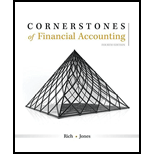
Future Value of a Single
Jenkins Products has just been paid $25,000 by Shirley Enterprises, which has owed Jenkins this amount for 30 months but been unable to pay because of financial difficulties. Had it been able to invest this cash, Jenkins assumes that it would have earned an interest rate of 12% compounded monthly (1% per month).
Required:
Note: Round answers to two decimal places.
1. Prepare a cash flow diagram for the investment that could have been made if Shirley had paid 30 months ago.
2. Determine how much Jenkins has lost by not receiving the $25.000 when it was due 30 months ago.
3. CONCEPTUAL CONNECTION Indicate whether Jenkins would make an entry to account for this loss. Why or why not?
Want to see the full answer?
Check out a sample textbook solution
Chapter A3 Solutions
Cornerstones of Financial Accounting
 Cornerstones of Financial AccountingAccountingISBN:9781337690881Author:Jay Rich, Jeff JonesPublisher:Cengage LearningPrinciples of Accounting Volume 2AccountingISBN:9781947172609Author:OpenStaxPublisher:OpenStax College
Cornerstones of Financial AccountingAccountingISBN:9781337690881Author:Jay Rich, Jeff JonesPublisher:Cengage LearningPrinciples of Accounting Volume 2AccountingISBN:9781947172609Author:OpenStaxPublisher:OpenStax College Financial Accounting: The Impact on Decision Make...AccountingISBN:9781305654174Author:Gary A. Porter, Curtis L. NortonPublisher:Cengage Learning
Financial Accounting: The Impact on Decision Make...AccountingISBN:9781305654174Author:Gary A. Porter, Curtis L. NortonPublisher:Cengage Learning


